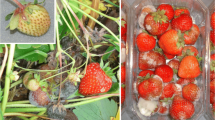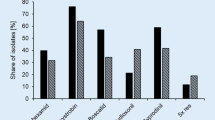Abstract
Second only to brown rot caused by Monilinia spp., grey mould caused by Botrytis spp. is one of the most important pre- and post-harvest diseases of stone fruit in northern Germany. Among 484 Botrytis isolates from sweet cherries produced under integrated pest management (IPM), 60.3% showed resistance to QoI fungicides and 54.6% to boscalid, reflecting the heavy use of these compounds in regional production. More modest resistance frequencies were recorded for fenhexamid (20.7%), fluopyram (8.3%), fludioxonil (9.1%) and cyprodinil (21.9%). A 7.6% share of isolates possessed multiple resistance to at least five of these fungicides. Resistance was also detected for two fungicides no longer registered in cherries, viz. thiophanate-methyl (15.7%) and iprodione (20.9%). Similar results were obtained for 141 Botrytis isolates from IPM plum orchards. In contrast, in organically produced cherries (88 Botrytis isolates) resistance frequencies were < 20% for all fungicides. The dominant species on cherries and plums was B. cinerea. The share of B. pseudocinerea, which is not known to have developed resistance to commercial fungicides, was 18.0% in cherries and 9.9% in plums from IPM, but 50.0% in organically produced cherries. A 10-year annual survey of a sweet cherry orchard under IPM showed the immigration of multi-resistant B. cinerea strains in 2011, followed by their increase and decline in subsequent years. An understanding of the effects of fungicide spray regimes on Botrytis population dynamics in stone fruit has implications for resistance management. In practice, a limitation of the number of pre-harvest sprays to a maximum of two will give a satisfactory control of brown rot in most situations, while a higher number will promote multi-resistant B. cinerea strains.





Similar content being viewed by others
References
Børve, J., & Stensvand, A. (2003). Use of a plastic rain shield reduces fruit decay and need for fungicides in sweet cherry. Plant Disease, 87, 523–528.
Børve, J., Sekse, L., & Stensvand, A. (2000). Cuticular fractures promote postharvest fruit rot in sweet cherries. Plant Disease, 84, 1180–1184.
Chen, S. N., Luo, C. X., Hu, M. J., & Schnabel, G. (2016). Fitness and competitive ability of Botrytis cinerea isolates with resistance to multiple chemical classes of fungicides. Phytopathology, 106, 997–1005.
Dowling, M. E., Hu, M.-J., & Schnabel, G. (2017). Identification and characterization of Botrytis fragariae isolates on strawberry in the United States. Plant Disease, 101, 1769–1773.
Hu, M.-J., Cox, K. D., & Schnabel, G. (2016). Resistance to increasing chemical classes of fungicides by virtue of “selection by association” in Botrytis cinerea. Phytopathology, 106, 1513–1520.
Langer, S. (2017). Der Witterungsverlauf von November 2015 bis Oktober 2016. Mitteilungen des Obstbauversuchsringes des Alten Landes, 72, 12–16.
Leroux, P. (2007). Chemical control of Botrytis and its resistance to chemical fungicides. In Y. Elad, B. Williamson, P. Tudzynski, & N. Delen (Eds.), Botrytis: Biology, pathology and control (pp. 195–222). Dordrecht: Springer.
Li, X., Fernández-Ortuño, D., Chen, S., Grabke, A., Luo, C.-X., Bridges, W. C., & Schnabel, G. (2014). Location-specific fungicide resistance profiles and evidence for stepwise accumulation of resistance in Botrytis cinerea. Plant Disease, 98, 1066–1074.
Markoglou, A. N., Malandrakis, A. A., Vitoratis, A. G., & Ziogas, B. N. (2006). Characterization of laboratory mutants of Botrytis cinerea resistant to QoI fungicides. European Journal of Plant Pathology, 115, 149–162.
Plesken, C., Weber, R. W. S., Rupp, S., Leroch, M., & Hahn, M. (2015). Botrytis pseudocinerea is a significant pathogen of several crop plants but susceptible to displacement by fungicide-resistant B. cinerea strains. Applied and Environmental Microbiology, 81, 7048–7056.
Rupp, S., Weber, R. W. S., Rieger, D., Detzel, P., & Hahn, M. (2017a). Spread of Botrytis cinerea strains with multiple fungicide resistance in German horticulture. Frontiers in Microbiology, 7, 2075.
Rupp, S., Plesken, S., Rumsey, S., Dowling, M., Schnabel, G., Weber, R. W. S., & Hahn, M. (2017b). Botrytis fragariae, a new species causing gray mold on strawberries, shows high frequencies of specific and efflux-based fungicide resistance. Applied and Environmental Microbiology, 83, e00269–17.
Veloukas, T., Markoglou, A. N., & Karaoglanidis, G. S. (2013). Differential effect of SdhB gene mutations on the sensitivity to SDHI fungicides in Botrytis cinerea. Plant Disease, 97, 118–122.
Walker, A.-S., Gautier, A., Confais, J., Martinho, D., Viaud, M., Le Pêcheur, P., Dupont, J., & Fournier, E. (2011). Botrytis pseudocinerea, a new cryptic species causing gray mold in French vineyards in sympatry with Botrytis cinerea. Phytopathology, 101, 1433–1445.
Weber, R. W. S. (2011). Resistance of Botrytis cinerea to multiple fungicides in northern German small fruit production. Plant Disease, 95, 1263–1269.
Weber, R. W. S., & Entrop, A.-P. (2011). Multiple fungicide resistance in Botrytis: A growing problem in German soft-fruit production. In N. Thajuddin (Ed.), Fungicides – Beneficial and harmful aspects (pp. 45–60). Rijeka: InTech Publishing.
Weber, R. W. S., & Entrop, A.-P. (2017). Recovery of Botrytis strains with multiple fungicide resistance from raspberry nursery plants. European Journal of Plant Pathology, 147, 933–936.
Weber, R. W. S., & Hahn, M. (2011). A rapid and simple method for determining fungicide resistance in Botrytis. Journal of Plant Diseases and Protection, 118, 17–25.
Weber, R. W. S., & Hahn, M. (2019). Grey mould disease of strawberry in northern Germany: Causal agents, fungicide resistance and management strategies. Applied Microbiology and Biotechnology, 103, 1589–1597.
Weber, R. W. S., Entrop, A.-P., Goertz, A., & Mehl, A. (2015). Status of sensitivity of northern German Botrytis populations to the new SDHI fungicide fluopyram prior to its release as a commercial fungicide. Journal of Plant Diseases and Protection, 122, 81–90.
Weber, R. W. S., Raddatz, C., & Kutz, S. (2018). Relative abundance and fungicide resistance patterns of Botrytis cinerea and B. pseudocinerea on apples in northern Germany. Journal of Plant Diseases and Protection, 125, 501–504.
Acknowledgements
We are grateful to Stefanie Kutz for technical assistance.
Author information
Authors and Affiliations
Corresponding author
Ethics declarations
Conflict of interest
The authors confirm that there is no conflict of interest.
Ethical approval
This review manuscript did not involve any human participants, and/or animals.
Rights and permissions
About this article
Cite this article
Hauschildt, M., Steinkellner, S. & Weber, R.W.S. Grey mould populations in northern German sweet cherry and plum orchards: selection of fungicide-resistant Botrytis cinerea strains over sensitive B. pseudocinerea by fungicide treatments. Eur J Plant Pathol 157, 615–623 (2020). https://doi.org/10.1007/s10658-020-02026-5
Accepted:
Published:
Issue Date:
DOI: https://doi.org/10.1007/s10658-020-02026-5




